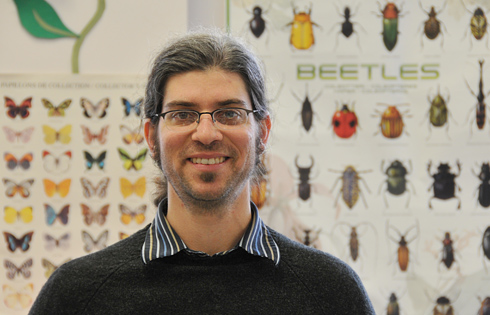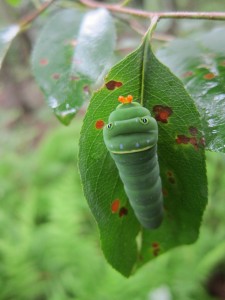Singer’s Study Reveals that Finicky Feeders Avoid Bird Predation
![singer2[1]](https://newsletter.blogs.wesleyan.edu/files/2014/06/singer21.jpg)

Grandmothers used to warn youngsters against being “a jack of all trades, and a master of none,” and with good reason, at least in the animal kingdom, according to research by Mike Singer, associate professor of biology, associate professor of environmental studies.
Singer’s decade of research in the ecosystems of Connecticut forests reveals that caterpillars with finicky feeding habits avoid predation from birds, whereas those that feed generally on many plants become meals for baby birds. The “specialist” bugs are much better at survival.
Singer and five collaborators published these findings in the prestigious Proceedings of the National Academy of Sciences June 16.

“Dietary specialization of herbivores drives the dynamics of this food chain,” Singer explained. Caterpillars with generalized diets are less likely than specialists to be camouflaged or to display warning colors or features to avian predators.
A familiar example of a dietary specialist is the caterpillar of the Monarch butterfly, which feeds exclusively on milkweed plants. This caterpillar accumulates toxins from its food-plants, rendering it unpalatable to birds and other predators. The toxic caterpillar is distinctively striped and colored as a warning to its enemies.
Singer’s study used a comparison of 41 caterpillar species to show the link between dietary breadth and vulnerability to predators. Previous studies had found the same pattern in other geographic locations. “What was novel about what we did is that earlier tests hadn’t been done with vertebrate predators, and the way we controlled for the evolutionary relationships … no one had done it within the context of an ecosystem where the herbivores were allowed to be on the plants,” Singer said.
By controlling for evolutionary relationships of the various caterpillars, the research revealed the fingerprint of evolution, if not the actual hand of natural selection. Several different lineages of butterflies and moths show the same link between specialized diets and reduced bird predation, a pattern called convergent evolution.
The work also sheds light on something called trophic cascades, in this case, the effect of predators on plants, mediated by herbivores. A tree’s level of avian protection against leaf-chewing herbivores depends on the dietary diversity of different species of caterpillars living on the tree. A tree harboring mostly generalist caterpillars receives the most help from birds.
Singer, who teaches content related to his research in ecology, conservation biology, and biodiversity, engages both graduate students and undergraduates in his fieldwork. It’s a practice he says is helpful not only to him, but to his students as they master biology. “I think it’s important that they get out into the environment as they’re learning,” he said.
Two of his co-authors are Wesleyan alumni, Isaac Lichter-Marck,’ 11, MA ’12, and Tim Farkas ’08, MA ’10. They were in Singer’s lab as both undergraduates and MA students in the BA/MA program.
The research was conducted in three forests near Middletown. The birds in the study are mostly songbirds – warblers, titmice and chickadees birds, for example – and the trees are familiar in the New England landscape, broadleaf deciduous varieties of oak, hickory, maple, beech and cherry. The 41 types of caterpillars studied mostly become moths (if they’re not eaten first).
Read a Q&A with Mike Singer here.
Read media coverage of the study in Audubon Magazine, Chicago Tribune, Discover and Science Daily.
| http://www.sciencedaily.com/releases/2014/06/140616151500.htm |

